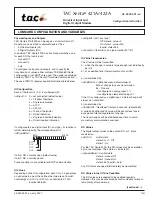
4 Programming: Fundamentals of NC, File Management, Programming Aids, Pallet Management
4.1 F
undamentals
Setting the datum
A production drawing identifies a certain form element of the
workpiece, usually a corner, as the absolute datum. Before setting the
datum, you align the workpiece with the machine axes and move the
tool in each axis to a known position relative to the workpiece. You
then set the TNC display to either zero or a predetermined position
value. This establishes the reference system for the workpiece, which
will be used for the TNC display and your part program.
If the production drawing is dimensioned in relative coordinates,
simply use the coordinate transformation cycles.(see “Coordinate
Transformation Cycles” on page 319).
If the production drawing is not dimensioned for NC, set the datum at
a position or corner on the workpiece, which is the most suitable for
deducing the dimensions of the remaining workpiece positions.
The fastest, easiest and most accurate way of setting the datum is by
using a 3-D touch probe from HEIDENHAIN. See the new Touch Probe
Cycles User’s Manual, chapter “Setting the Datum with a 3-D Touch
Probe.”
Example
The workpiece drawing at right shows holes (
1
to
4
) whose
dimensions are shown with respect to an absolute datum with the
coordinates X=0, Y=0. The holes (
5
to
7
) are dimensioned with respect
to a relative datum with the absolute coordinates X=450, Y=750. With
the
DATUM SHIFT
cycle you can temporarily set the datum to the
position X=450, Y=750, to be able to program the holes (
5
to
7
)
without further calculations.
Y
X
Z
MAX
MIN
X
Y
325
320
0
450
900
950
150
-150
750
0
300
±
0,
1
11
12
15
13
14
16
17
Summary of Contents for TNC 426
Page 3: ......
Page 4: ......
Page 8: ...IV...
Page 10: ...VI...
Page 26: ......
Page 27: ...1 Introduction...
Page 41: ...2 Manual Operation and Setup...
Page 54: ......
Page 55: ...3 Positioning with Manual Data Input MDI...
Page 59: ...4 Programming Fundamentals of NC File Management Programming Aids Pallet Management...
Page 122: ......
Page 123: ...5 Programming Tools...
Page 153: ...6 Programming Programming Contours...
Page 201: ...7 Programming Miscellaneous functions...
Page 226: ......
Page 227: ...8 Programming Cycles...
Page 366: ......
Page 367: ...9 Programming Subprograms and Program Section Repeats...
Page 381: ...10 Programming Q Parameters...
Page 424: ......
Page 425: ...11 Test run and Program Run...
Page 443: ...12 MOD Functions...
Page 472: ......
Page 473: ...13 Tables and Overviews...
Page 496: ......
















































